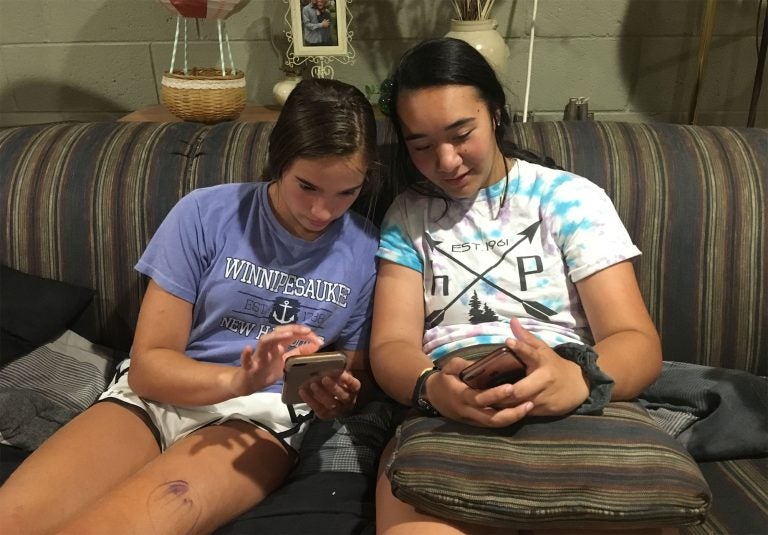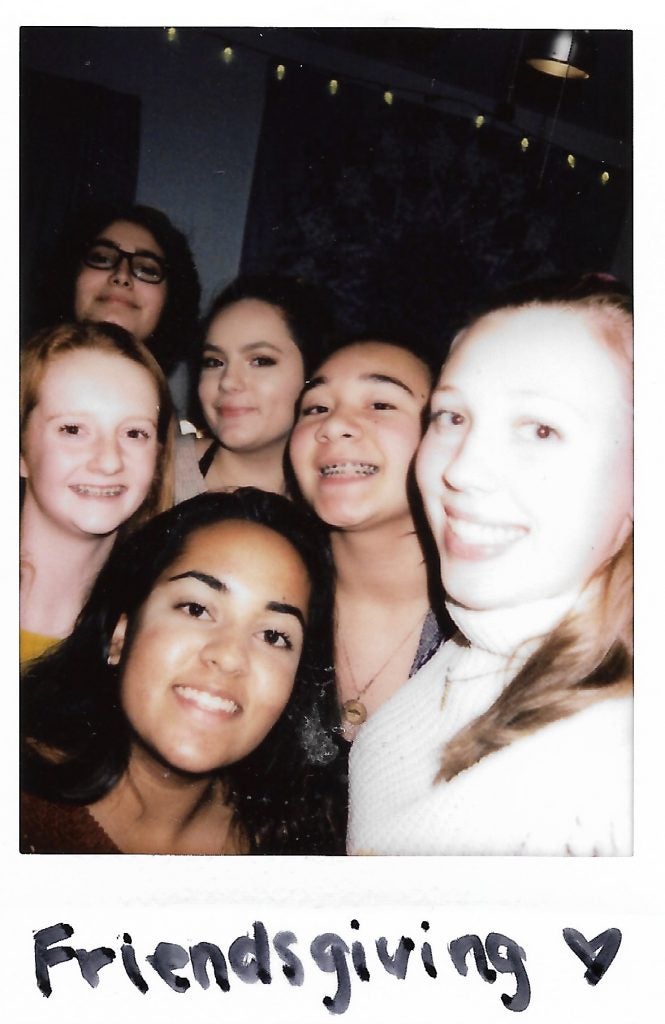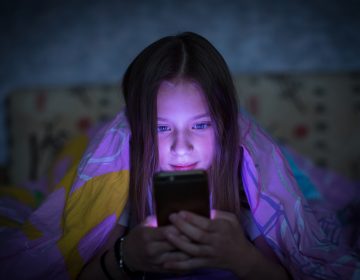Put down the phones and let’s talk, these teenagers say
These days, limiting time spent on smartphones is a challenge for adults and teenagers alike.
Listen 4:44
Kim Delea (left) and Alyssa Carroll, eyes on their smartphones. (Randy Scott Carroll for WHYY)
How do we help children thrive and stay healthy in today’s world? Check out our Modern Kids series for more stories.
—
Alyssa Carroll and Kim Delea go Garnet Valley High School, but they’ve been best friends since first grade.
“A long time,” the girls, both 16, agreed, laughing about it.
Everyone in their Delaware County high school has a smartphone, they said, but Delea feels like it gets in the way of real connection.
“I’ve gone to parties where people literally sit on the couch and are just like texting, playing games, or on Snapchat or Instagram the entire time,” she said.
“It’s like a domino effect,” said Carroll. “That person’s on her phone now, that person’s on their phone, and then everyone’s on their phone and no one’s doing anything.”
These days, limiting time spent on smartphones is a challenge for adults and teenagers alike. Carroll and Delea are trying to do just that. (Disclosure: Alyssa Carroll is the reporter’s younger sister. Her insights, and Delea’s, inspired this story.)
According to Pew Research Center Internet and Technology reports based on a survey conducted last year with 743 young people between the ages of 13 and 17, more than half of teenagers in the United States, 54%, admit they spend too much time on their phones.
“Roughly nine-in-10 teens view spending too much time online as a problem facing people their age, including 60% who say it is a major problem,” the Pew survey showed.
Pew’s research also found that while teens say social media strengthens their friendships and exposes them to a more diverse world, it can also cause a lot of social angst.
“It’s just like an extra drama that’s going on,” said Delea.
“Rather than just leaving it in a certain spot, it’s now in your everyday life because you have your phones everywhere, and then they communicate to you through your phone. So now … it’s every day, wherever you are, because you have your phone with you,” said Carroll.
Around the holidays last year, the girls decided to host a dinner party for all of their friends — a “friendsgiving.” And it was planned mostly through their phones.
“Time, place, what we’re doing, what we’re eating, what we’re wearing, who’s all coming … nothing was talked about in person,” said Carroll.
When they finally got together and their friends were still on their phones, the girls said, they spoke up. They had everyone try setting their phones in the other room, to try and be more present. It was the first time they’d ever done anything like this.

“We sat around the table, and then we just talked, like actually talked to each other,” said Carroll. “We got out a board game and all started playing a board game — like, you don’t do that nowadays … I feel like we talked a lot more, like got into more topics.”
“There was an actual conversation. Instead of, like, ‘Oh, look what I just saw on my phone,’ ” said Delea.
For teens today, learning to set their own limits and negotiating how much they can be on their phones with the adults in their lives, is a “constant topic of conversation,” said Katherine Dahlsgaard, clinical director of the anxiety behaviors clinic at Children’s Hospital of Philadelphia.
She said people need to understand that screen time isn’t good or bad.
“It seems to be that that’s the starting point for a lot of parents: ‘Is screen time good or bad for my kids?’ … And I counsel them away from that, right. That’s an all-or-nothing question,” Dahlsgaard said.
The most consistent advice she gives adults when it comes to the teenagers in their lives, she said, is not to set expectations too high.
“I don’t mean that as a knock against their parenting or against teenagers in general, but you have to understand the neuroscience of adolescence,” Dahlsgaard said. “Their brains are swimming with dopamine, pickled in dopamine. Dopamine is the neurotransmitter of reward. So it’s all a reward for them.”
She said the prefrontal cortex, the part of the brain that weighs risks and consequences, is still developing in teens.
“They don’t quite have the full functioning of their executive functioning that says, `OK, let me think about this. What are the short-term and long-term consequences of the choice I’m about to make with regard to screen time.’ ”
The other thing, Dahlsgaard said, is that parents need to model the sorts of behaviors they want teens to emulate.
Ask yourself questions like, “Do you want to create screen-free zones?” she said. “When is it OK to use screens on the fly? When is it OK to break a rule just to self-soothe there because it’s convenient? How does your use of screen square with your goals and your values for yourself?”
In other words, develop achievable expectations for you and your kids. And, if you’re worried about how social media can affect your teens, make sure you understand how it affects you.
“Because there is no more lucrative an audience than an anxious parent.” Dahlsgaard said.
Like any parenting advice, it’s about consistency, with the knowledge that eventually kids will learn what works for them, she said.
“The developmental achievement of adolescence is identity formation,” Dahlsgaard said. “They really do have to do a lot of trial and error … so screen time is not this ogre. It is another tool to which I will be parenting.”
Katherine Napalinga, a child and adolescent psychiatrist with Einstein Healthcare Network, said there are nonverbal messages when you’re talking to someone in person that can be missed on the phone — like, “I’m glad you’re here.”
“Sure, you’re talking, you can understand each other or you’re chatting, but there’s a lot of context that’s missed,” she said.
“And if you’re growing and you’re learning … your social skills, [like] how to get along with others, how to feel self-confident, you’re not getting as much experience … if you’re just living virtual worlds all the time,” Napalinga said.
Since their “friendsgiving,” Carroll and Delea said, they have made a more conscious effort to limit their phone use by turning off certain notifications, and by recognizing that feeling of not being present.
“When we’re hanging out and we realize we’re on our phone too much, we’re like, let’s just put it down and go outside and do something else,” said Delea.
Carroll just finished up a couple weeks at summer camp. She left her phone at home.
“I’d rather be out making new friends,” she said, “or doing the activities they have at camp than being on my phone and not being where I’m at — like trying to be somewhere else at the same time.”
WHYY is your source for fact-based, in-depth journalism and information. As a nonprofit organization, we rely on financial support from readers like you. Please give today.





